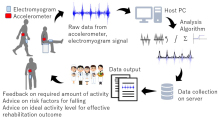Assistive technologies to enhance quality of life of older people

February 2018 to February 2019
Lead research institution: Wakayama Medical University
Other participating research institutions: Osaka Medical College, Japan; Nara Medical University, Japan; Kyoto Prefectural University of Medicine, Japan; Kindai University, Japan
Principal investigators: Dr Fumihiro Tajima, Wakayama Medical University
Japan
Background
While life expectancy (LE) is increasing globally, healthy life expectancy (HLE) is not increasing at the same pace. As such, in some settings, people are living longer with additional years of disability. This gap between LE and HLE is associated with progressive loss of physical, mental and cognitive integrity, overall affecting the activities of daily life (ADL) and quality of life of older people. Older people could be affected by a progressive loss of muscle mass and function, a condition referred to as “sarcopenia”, which is present in 1 to 50% of community-dwelling older adults. Physical inactivity contributes to the development of sarcopenia, and among older adults, this risk is accrued due to high burden of disease-related immobility or disability. Decreased muscle mass and function leads to diminished muscle strength and increased vulnerability to falls, subsequently resulting in fractures, disability and death.
Improvement in physical capacity leads to improvement in functional capacity. The maintenance and improvement of physical function for older people is critical in retaining ADL and quality of life. New technologies are rapidly emerging and are showing great potential for monitoring physical activities for older people. Data and information captured by these new assistive technologies could help design programmes to improve physical activity, prevent gait disorders and improve quality of life of older people.
Goal
The goals of the research are three-fold:
- To develop a new algorithm for assessing the amount of physical activity required to maintain ADL and walking function among older adults.
- To document the patterns of falls and identify risks of specific physical activities and postures that affect the frequency of fall.
- To determine the optimum physical activity level for achieving better rehabilitation outcomes for inpatients.
Methods
This research consists of three parts. Part I is a pilot study involving 20 healthy volunteers (over 20 years) to measure physical activity through electromyogram (EMG) signals of the anterior thigh muscle. The new algorithm will be tested on a sample of 20 older adults aged 65 years and older. Part II is an observational study targeting 50 community-dwelling adults 65 years and older. Data about patterns of fall and physical activity were recorded using a non-invasive and validated accelerometer. Part III is an observational study of inpatients 20 years and older undergoing rehabilitation therapy for six types of conditions. Physical activity was measured using a validated accelerometer over seven continuous days from the start of the rehabilitation. In addition, body composition was measured using a portable medical body composition analyser.
Results
A significant positive correlation was found between the sum of root mean square of electromyographic signal and oxygen consumption during both ergometer exercise and walking. Preliminary data were collected among healthy subjects to develop a new application programme for the wearable accelerometer. Among inpatients, not increase in skeletal muscle mass was detected for hospitalized patients with chronic obstructive pulmonary disease (COPD) or heart failure who received conventional pulmonary or cardiac rehabilitation therapy.
Implications
The findings will contribute to an algorithm for estimating energy expenditure and to the development of a telemetry monitoring system for hospitalized patients. The lack of change in the mass of skeletal muscle in hospitalized patients, as shown in part III of the study, calls for a re-examination of the current pulmonary and cardiac rehabilitation programmes and exploration of new interventions.

Related PDF downloads:
- Document

